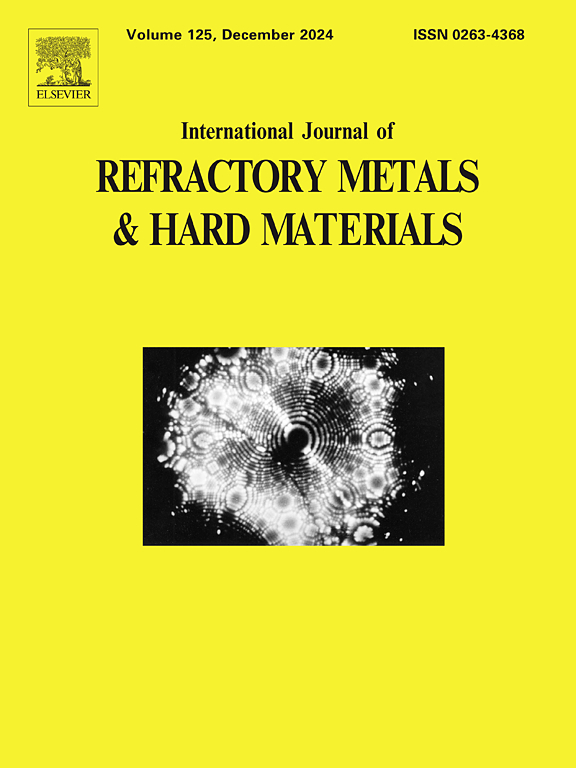Fabrication of porous tungsten with tunable pore structures via low-temperature pressureless sintering: Processing and mechanisms
IF 4.6
2区 材料科学
Q2 MATERIALS SCIENCE, MULTIDISCIPLINARY
International Journal of Refractory Metals & Hard Materials
Pub Date : 2025-06-24
DOI:10.1016/j.ijrmhm.2025.107300
引用次数: 0
Abstract
Porous tungsten plays a critical role in field emission electric propulsion (FEEP) thrusters by synergistically combining sharp emitter tips with efficient internal propellant transport. The emission performance of FEEP thrusters exhibits strong dependence on the emitter's porosity and pore density. Nevertheless, conventional fabrication methods for porous tungsten face challenges in achieving porosity levels of 20–40 % concurrently with precise pore density control. This study proposes a fabrication strategy that integrates wet ball milling with powder metallurgy, enabling pressureless sintering at low temperatures (1200–1500 °C). The developed method allows for the synthesis of porous tungsten featuring uniform pore size and homogeneous pore distribution. Through precise regulation of sintering temperature and holding time, we achieved porous tungsten with controlled porosity (21.98–38.16 %), pore density (2.2–16.32 pores/10μm2), peak compressive strength of 987.2 MPa, and Vickers hardness ranging from 107.77 to 204.85 HV. The growth kinetics of sintering necks were analyzed based on the Kuczynski model, yielding a scaling exponent n = 4.50 and activation energy Q. Fitting of necks in porous tungsten prepared with varied ball-milling durations revealed the mechanistic influence of milling on powder sintering activity. These results underscore bulk diffusion as the predominant mass transport mechanism, with the reduced activation energy attributed to enhanced sintering kinetics from ultrafine powders and optimized milling processes. This work provides a theoretical framework for successful low-temperature sintering of porous tungsten.
低温无压烧结制备具有可调孔结构的多孔钨:工艺和机理
多孔钨通过将尖锐的发射极尖端与高效的内部推进剂输送协同结合,在场发射电推进(FEEP)推进器中发挥着至关重要的作用。FEEP推进器的发射性能与发射体的孔隙率和孔隙密度密切相关。然而,传统的多孔钨制造方法在实现20 - 40%的孔隙率水平和精确的孔隙密度控制方面面临挑战。本研究提出了一种将湿球磨与粉末冶金相结合的制造策略,可以在低温(1200-1500°C)下实现无压烧结。所开发的方法可以合成孔径均匀、孔隙分布均匀的多孔钨。通过精确调节烧结温度和保温时间,制备出孔隙率为21.98 ~ 38.16%、孔隙密度为2.2 ~ 16.32孔/10μm2、峰值抗压强度为987.2 MPa、维氏硬度为107.77 ~ 204.85 HV的多孔钨。基于Kuczynski模型分析了烧结颈的生长动力学,得到结垢指数n = 4.50和活化能Q.对不同球磨时间制备的多孔钨的颈进行拟合,揭示了球磨对粉末烧结活性的机理影响。这些结果强调了体扩散是主要的质量传递机制,而降低的活化能归因于超细粉末烧结动力学的增强和优化的磨粉工艺。本研究为多孔钨的低温烧结成功提供了理论框架。
本文章由计算机程序翻译,如有差异,请以英文原文为准。
求助全文
约1分钟内获得全文
求助全文
来源期刊
CiteScore
7.00
自引率
13.90%
发文量
236
审稿时长
35 days
期刊介绍:
The International Journal of Refractory Metals and Hard Materials (IJRMHM) publishes original research articles concerned with all aspects of refractory metals and hard materials. Refractory metals are defined as metals with melting points higher than 1800 °C. These are tungsten, molybdenum, chromium, tantalum, niobium, hafnium, and rhenium, as well as many compounds and alloys based thereupon. Hard materials that are included in the scope of this journal are defined as materials with hardness values higher than 1000 kg/mm2, primarily intended for applications as manufacturing tools or wear resistant components in mechanical systems. Thus they encompass carbides, nitrides and borides of metals, and related compounds. A special focus of this journal is put on the family of hardmetals, which is also known as cemented tungsten carbide, and cermets which are based on titanium carbide and carbonitrides with or without a metal binder. Ceramics and superhard materials including diamond and cubic boron nitride may also be accepted provided the subject material is presented as hard materials as defined above.

 求助内容:
求助内容: 应助结果提醒方式:
应助结果提醒方式:


